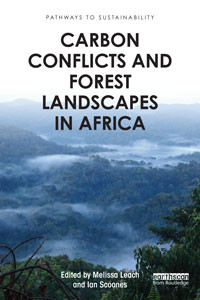 Carbon Conflicts and Forest Landscapes in Africa, edited by Melissa Leach and Ian Scoones, examines the management of forests and carbon.
Carbon Conflicts and Forest Landscapes in Africa, edited by Melissa Leach and Ian Scoones, examines the management of forests and carbon.
Tackling climate change is one of the most pressing challenges of our age. And this year is a crucial moment with the Conference of the Parties meeting in Paris in December 2015 to forge a new climate agreement. Forests, carbon and their management are high on the agenda, and a new book from the STEPS Centre and edited by Melissa Leach and Ian Scoones – Carbon Conflicts and Forest Landscapes in Africa – dissects the issues, and points to ways forward.
Deforestation and land degradation globally contribute significantly to carbon emissions, and addressing these has become a major policy priority. Carbon offset approaches, mediated by carbon markets and facilitated by international accords and global climate finance, have become especially popular. In such schemes carbon emissions in one part of the world (usually the industrialised north) are offset by initiatives that reduce emissions in another part of the world where there are plentiful forests, and opportunities for new carbon sequestration (such as Africa). Such projects can, it is argued, additionally focus on poverty reduction and biodiversity protection, creating a ‘win-win’ scenario.
This is the theory. But what of the practice? This book is about what happens on the ground when carbon forestry projects – existing in various guises, often under the umbrella of the Reduced Emissions for Deforestation and Forest Degradation (REDD Plus) programme – arrive. In this new field of environment and development practice, there are many new players, a whole panoply of models, processes and procedures for verification and monitoring, and a hot politics of authority and control. Understanding what works, and what doesn’t is crucial, and this book offers some salutary lessons on the feasibility and desirability of market-based offset approaches to carbon mitigation.
Through a series of detailed case studies from seven countries, from east, west and southern Africa, the chapters ask what actually happens when carbon forestry projects unfold in particular places: who wins, and who loses out, and what are the consequences – for carbon sequestration and offsetting, as well as poverty reduction? As all the cases show, carbon projects do not arrive on a blank slate. All sites have long histories of intervention, including a whole array of forestry, environmental protection and development projects. These have shaped and reshaped livelihoods and landscapes, and generated experiences and memories that influence local responses to new interventions.
The book’s case studies cover a wide range of African ecologies, project types and national political-economic contexts. The book asks: what difference does carbon make? What political and ecological dynamics are unleashed by these new commodified, marketized approaches, and how are local forest users experiencing and responding to them? Carbon forestry projects – as previous interventions in forest use, ownership and management – have not been the panacea some had expected. Multiple conflicts have emerged between land owners, forest users and project developers. Achieving a neat, market-based solution to climate mitigation through forest carbon projects not straightforward.
A new politics of access and control over forests and their carbon is emerging, making the noble aims of climate mitigation through carbon forestry very challenging. The book identifies the need to address conflicts head on, and to develop a more politically sophisticated approach to carbon governance in complex landscapes. The book thus provides a rich and compelling account of how and why carbon conflicts are emerging, and how they might be avoided in future. For all those engaged in the debates in the lead up to Paris and beyond, this book offers some sanguine insights and cautionary tales around the limits of market-based carbon forestry. However, it also points to ways forward that take account of the complex, layered politics of Africa’s forest landscapes.
The book includes chapters from Melissa Leach and Ian Scoones, Albert A. Arhin, Joanes Atela, Martin Kijazi, Adrian Nel, Guni Mickels-Kokwe, Misael Kokwe, Vupenyu Dzingirai and Lindiwe Mangwanya, Ishmael Hashmiu and Thomas Winnebah.
Esteve Corbera, Universitat Autònoma de Barcelona, Spain said: “This book not only synthesizes what we know about carbon forestry and illustrate how it has unfolded in Africa, it also critically reflects on the material, social and cultural life of carbon and how the latter features amidst dynamic ecologies and the development needs and aspirations of states and people. This is a brilliant book; a must read for scholars and activists interested in the commodification of environmental services and their likely consequences.”
And Gretchen Walters, International Union for the Conservation of Nature (IUCN), Switzerland added: “This book will help readers better understand why it is important to incorporate livelihood considerations and a landscape approach into the design and implementation of forest carbon projects.”
- LAUNCH DISCOUNT OFFER: Buy the book at a discount of 20% by using the DC361 on the Routledge website
- See all the books in the STEPS Pathways to Sustainability series
Comments are closed.